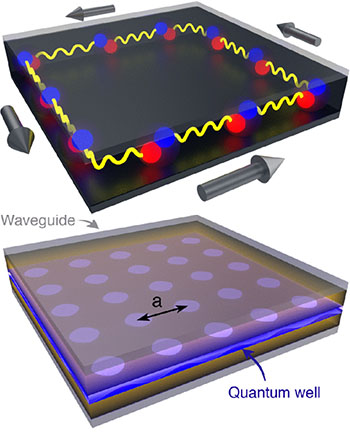
(Top) The proposed topolariton, a mixture of exciton and photon states, features “chiral edge modes” that could allow their bound photons to travel in only one direction on the system edges, eliminating loss from backscatter. (Bottom) Possible experimental setup for generating topolaritons, in which a semiconductor quantum well is embedded in a photonic waveguide or cavity. [Images: Karzig et al., Phys. Rev. X, doi: 10.1103/PhysRevX.5.031001]
Physicists at the California Institute of Technology (USA) have proposed a new type of hybrid particle, the topological polariton, or “topolariton,” that is a mixture of a single photon and a single exciton (the bound state of an electron and an electron hole in semiconductors and insulating materials). The theoretical “quasiparticle”—essentially half light and half matter—would, according to the research team, be inherently immune from backscattering. Thus these hybrid particles, if realized experimentally, could offer a way to create “one-way roads” for photons, and to reduce noise attributable to backscattering in photonic systems such optical fibers and lasers (Phys. Rev. X, doi: 10.1103/PhysRevX.5.031001).
A photon-exciton “knot”
The notion of the topolariton flows from the larger study of topological order, a recent hot spot in condensed-matter physics. Systems with topological order have important characteristics that depend only on the system’s topology, or geometrical properties. The most notable example has been so-called topological insulators—condensed-matter systems that act as insulators in bulk but as conductors on their edges. In the past several years, experimentalists have brought similar ideas to the photonic realm, creating systems that, for example, have a photonic band gap in bulk but transmit light on their edges (see “Demystifying Topological Order with Photons,” OPN, July/August 2014).
Taking a next step in thinking about combining condensed-matter physics and photonics, the Caltech team considered the theoretical topological state that might arise from coupling a photon with a semiconductor exciton. They showed, both mathematically and numerically, that achieving such a superposition of light and matter quanta would produce “nontrivial topology” characterized by mixing or “knotting” of the electron and photon energy-band structures. They dubbed this theoretical quasiparticle a topological polariton, or topolariton.
One-way street for photons
The “knottiness” of the topolaritons is a key to their potential application in real photonic systems, according to the scientists. Because they arise from the topological order of the system, the topolariton knots exist in the system’s bulk state; at the edges or boundaries of the system, the knots must be undone. And, because the topolariton knots by definition have a specific chirality, or handedness, they can only be undone in one direction.
Thus the topolaritons create special edge modes in the system that allow, in principle, for their embedded light to be transported only in one direction on the edges—that is, to entirely avoid backscattering. The use of topolaritons might allow for improved performance in optical waveguides and photonic devices, if the quasiparticles—which, at this point, exist only in numerical models—can indeed be generated in the real world.
Such realization “seems within experimental reach,” according to the researchers, who suggest that topolaritons might be generated by embedding semiconducting quantum wells or certain 2-D materials into photonic waveguides. An external magnetic field could be used to do the heavy lifting of tying the topolariton knots and controlling their sense. Under this scheme, the directionality of the one-way photons could even be reversed on demand, by flipping the external magnetic field.
